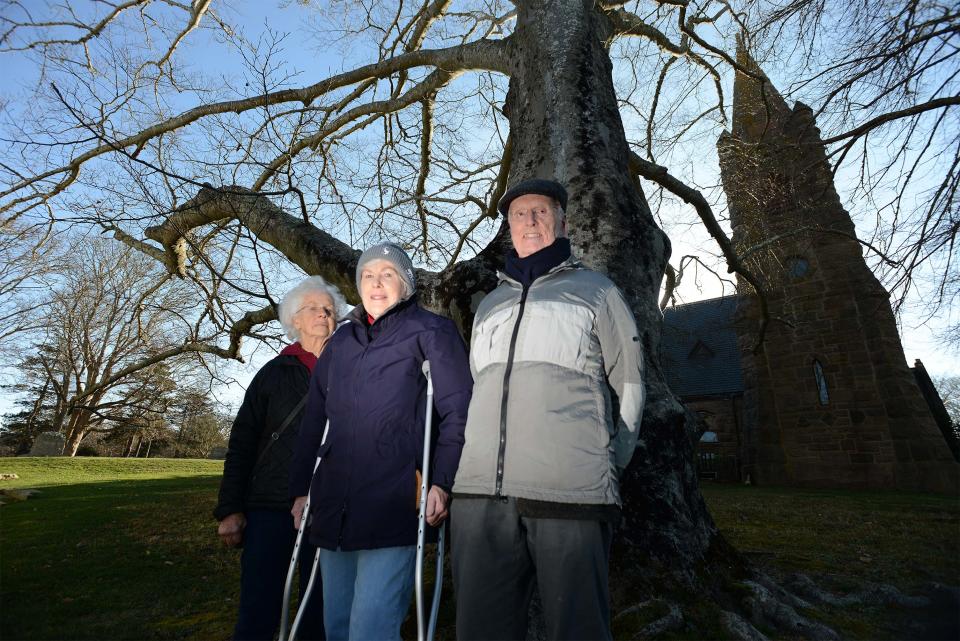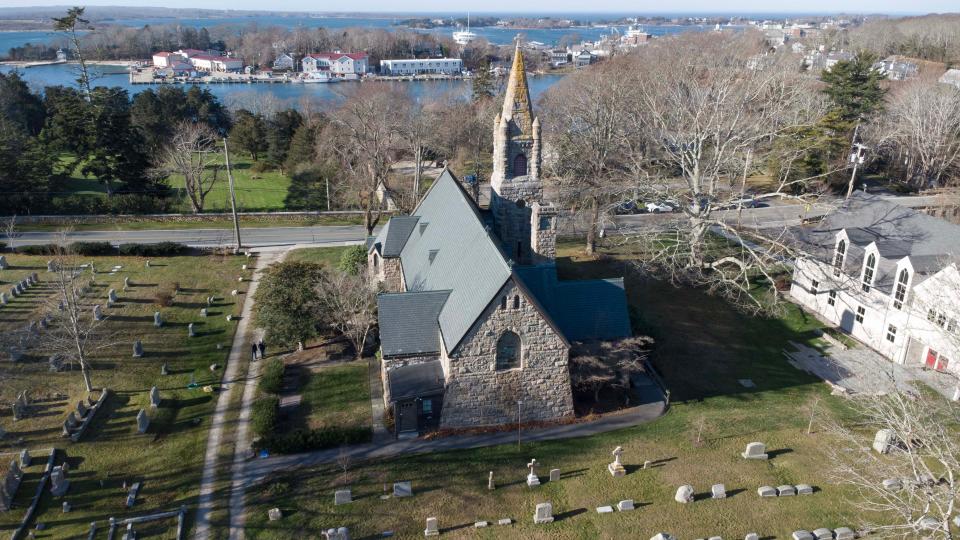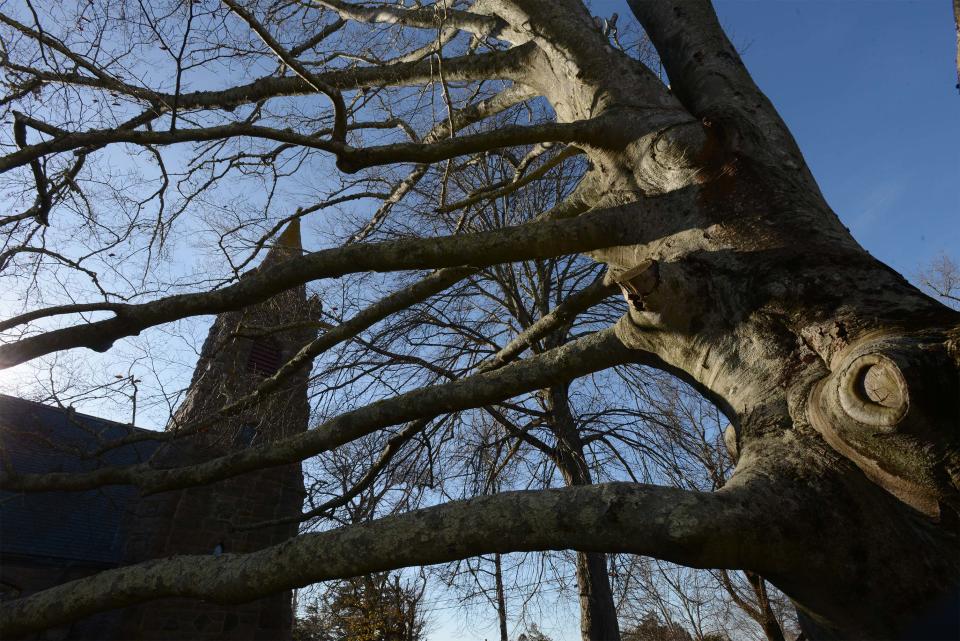'A mere shadow.' Woods Hole parishioners bid farewell as beloved beech tree nears its end
WOODS HOLE — Once there was a little beech tree that began to grow in Woods Hole, on a spot between an old stone church and an even older wooden church.
As she grew in height and girth, little boys and girls would climb up her trunk, and sometimes swing from her branches, and everyone would enjoy her shade. The people loved the tree very much, and the tree was happy.
But as time went by, the tree grew sick. One summer her leaves were thick and green, the next they were sparse, ragged and curling on the edges. And the people soon understood they were losing their beloved tree.
That's the story, in a beechnut shell, of the European beech tree growing on the grounds of The Church of the Messiah, unfurling its roots along a gentle, moss-carpeted slope between the church's 1888 stone edifice and the renovated 1852 first church building that now serves as the community and parish center.

Parishioners, who refer to the tree as she, believe it took root sometime in the 1920s, is afflicted with beech leaf disease — a condition that's spreading among beech trees across the region. In early January, the tree that has graced the Cape's oldest Episcopal church is scheduled to be removed.
"It's sad to see magnificent trees like this go," said Peg Nicholson, a senior warden of the church, as she stood recently on the second level of the parish center gazing at the tree framed by one of the tall lancet windows.
Outside, a biting December wind teased tendrils of pale lichen hanging onto the branches like peeling wallpaper and tugged at a single, dried and shriveled brown leaf refusing to let go yet.
Describing a photo of the tree in leaf from 2019, compared to one taken this summer, Nicholson said, the difference is stark.
"This summer it was a mere shadow of its former self," she said.
She was joined by parishioner Mary Anne Mann, who recently put together a two-page handout about the tree, and parishioner Charles Mann (unrelated to Mary Anne), who is involved with plans for adding pathways between the church and the parish center as part of ongoing campus upgrades.
"It's been a beautiful tree," said Mary Anne Mann. "It is a shame."
The tree measures about 13 feet and 7 inches in circumference at its base.
At one time, there were three beeches on the slope, Charles Mann said. Two were removed around 2018 when the project to renovate the wooden church began, because they were too close to the building.
When the three beeches were present, he said, they grew so close together that the tree that remains sent its branches out mostly in one direction, now appearing, in its solitude, as if it spent its entire life bent by ocean winds blowing off nearby Vineyard Sound.
"It's not a classic specimen beech tree. One half of it is, but the other half isn't," he said. Still, "it's been a favorite tree of the parish community. People are very fond of it."

So much so that when the parish started planning the pathways project, "we went to great lengths with our landscape architect to design paths around the beech tree," he said.
But then the tree declined, weakened by the 2022 drought, and beset not only with beech canker disease but also the rapidly spreading beech leaf disease.
How widespread is beech leaf disease?
Russell Norton, a horticulture extension educator for the Cape Cod Cooperative Extension, said beech leaf disease was first observed in Ohio around 2012. It's been spreading in the northeast ever since and was first identified in Massachusetts beeches in Plymouth in 2020. It was confirmed on Cape Cod in 2022, and detected on beeches at the Polly Hill Arboretum in West Tisbury, on Martha's Vineyard, in May.
"Beech leaf disease is pretty widespread at this point in our beech populations here in Barnstable County," he said.
What are the symptoms of beech leaf disease, and what causes it?
Among the symptoms are the appearance of dark bands on the leaves, in addition to leaves that are "distorted, tattered, leathery" or smaller, and thinning canopies.
"It's actually caused by a nematode. They are microscopic roundworms," Norton said.
Their presence in the leaves affects the tree's ability to photosynthesize and produce the sugars it needs to thrive. Beyond that, he said, "the nematodes can get into the buds and it's here where a lot of the damage is done. It causes the buds to abort or die."
Researchers at the UMass Extension Landscape, Nursery and Urban Forestry Program at the University of Massachusetts Amherst say the nematodes likely are spread by birds and insects. Scientists at the Connecticut Agricultural Experiment Station theorize some animals, such as squirrels, may also spread them.
It is unknown where the nematodes originated, but there is growing evidence they are not native to North America, according to the Connecticut research station.
Once infected, many beech trees die within five to seven years. Norton said researchers are working to develop treatments. But the tools, he said, "are somewhat limited" to the treatment of individual, ornamental trees that are part of a maintained landscape.
"They're not things you'd necessarily implement on a forest-level scale," he said.
Woods Hole parishioners have fond memories of their beech
Back at The Church of the Messiah in Woods Hole, identifying the disease in the tree came too late to try applying treatments — symptoms are more difficult to detect on European beech trees than on American beeches.
Earlier this month, parishioners, led by the interim rector Rev. David Rider, gathered in the parish center to celebrate the life of the tree. Many members have special memories of the tree, Charles Mann said.
"The stories about the tree usually have some sort of climbing in them," he said.
"The kids always spent time on the branches," said Mary Anne Mann.
There are plans to plant three new trees on the church grounds, but no decision yet about what type they will be. The leading contenders are Pin oak or American elm. Whatever the choice is, Charles Mann said, "We want to plant at least one that can grow at least as large as the beech."
The beech tree will keep on giving
Hamilton Tree & Landscape in Falmouth is contracted to take down the beech tree next month as the weather allows. But that won't be the end of her story.

The much-loved beech tree that has given so much to the church community is not quite finished giving — not unlike "The Giving Tree" in Shel Silverstein's well-known children's book.
Jeff Corwin, a longtime summer resident of Woods Hole and a retired Marine Biological Laboratory researcher and instructor, is a woodturner "who will give the beech tree newlife by creating keepsakes and functional items for sale to interested parishioners," according to a flyer created by Mary Anne Mann.
"He is a very accomplished woodworker," said Charles Mann, noting Corwin can create everything from bowls and platters to Christmas ornaments, pens, knickknack boxes and goblets.
So, even though the tree will no longer spread her branches over the church grounds, she will still be cherished by her people. Anyone interested in a keepsake can contact Corwin by email at corwin@virginia.edu
Heather McCarron writes about climate change, environment, energy, science and the natural world, in addition to news and features in Barnstable and Brewster. Reach her at hmccarron@capecodonline.com, or follow her on X @HMcCarron_CCT
The Cape Cod Times mobile app gets you to the heart of the matter — fast. Whether breaking news, sports, entertainment or weather get succinct, personalized coverage along with award-winning videos, captivating photography, and interactive user features. Download the app.
This article originally appeared on Cape Cod Times: Church of the Messiah in Woods Hole prepares to let go of beech tree

